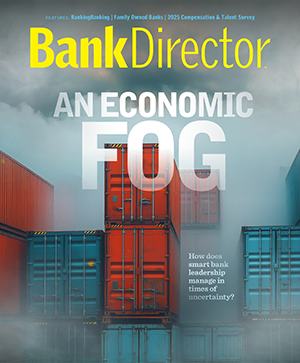Jackie Stewart is the Executive Editor of Bank Director. She is responsible for writing and editing features for the company’s weekly newsletter and quarterly print magazine and oversees sponsored research reports. Jackie is particularly interested in community banking and M&A activity. She previously served in a number of reporter and editor roles with American Banker, including executive editor of American Banker Magazine. She has also covered retirement issues for Kiplinger and spent two years teaching middle school literacy in the Bronx, New York, through Teach For America.

Big Bank M&A Poised to Return
A number of large banks are likely interested in once again pursuing transactions, and this could happen if the regulatory environment shifts as expected, according to Piper Sandler Companies’ Bill Burgess.
Large banks could finally get off the sidelines and start pursuing deals again.
But a few things would need to happen first, said Bill Burgess, co-head of the financial services investment banking group at Piper Sandler Companies, during Bank Director’s Bank C-Suite Summit on Monday.
Heading into 2025, there were expectations that overall bank M&A would pick up. There was a widespread assumption that the Trump administration would approve transactions quicker. Some of President Donald Trump’s nominations and appointments support this prediction. For instance, Travis Hill, who Trump named as acting chairman of the Federal Deposit Insurance Corp., said his goal is “to ensure that merger transactions that satisfy the Bank Merger Act are approved in a timely way.”
And the year did start off that way. Burgess said that deal activity was “off to an OK start” until about April.
That’s when, in early April, Trump announced widespread tariffs, which sent bank stocks tumbling along with the broader market. He later announced a pause on the majority of the tariffs and bank stock prices have somewhat since recovered. But the issue of tariffs is still creating a level of uncertainty.
Thirty-four bank deals totaling roughly $1.6 billion were announced in the first quarter, according to S&P Global Market Intelligence. That’s the highest total in the first quarter since 2021.
There are some signs that larger deals could be picking up. In April, Tacoma, Washington-based Columbia Banking System announced that it would acquire Irvine, California-based Pacific Premier Bancorp in a deal valued at $2 billion that would create a $70 billion institution.
For deals announced through April 24 with a value of more than $15 million, the median transaction value was $194 million, according to data from Piper Sandler. Last year, this figure was $121 million and $73 million in 2023.
Still, there haven’t been many of the blockbuster deals that defined M&A activity several years ago.
Long regulatory delays in getting previous big bank deals done is one of the drivers behind that, Burgess said. In 2021 and 2022, three large deals were announced — Toronto-based BMO Financial Group announced it would buy Bank of the West, Toronto-based TD Bank Group said it would acquire First Horizon Corp. and Minneapolis-based U.S. Bancorp announced it would acquire MUFG Union Bank. The BMO and U.S. Bank deals took more than a year to close, and the TD-First Horizon transaction was eventually scrapped.
That gave other potential large acquirers pause, Burgess said.
“The rules were unknown to the large banks,” he added. “I met with a large acquirer, and they said, ‘Before I enter the playing field, I kind of want to know what the rules are.’”
Burgess noted that there is likely a desire for banks with between $75 billion to $100 billion in assets to complete more transactions. A number of these institutions have traditionally been acquirers but Burgess said that they may be concerned about crossing the systematically important financial institution, or SIFI, threshold, which brings additional costs and regulatory scrutiny. In 2018, the SIFI level was raised from $50 billion in assets to $100 billion and then eventually $250 billion. Over the next five years, 15 banks crossed the $50 billion threshold, according to Piper Sandler. That indicates more institutions could be willing to grow if it didn’t mean triggering additional regulatory costs.
During the Biden administration, there was a push to implement additional stress testing and liquidity rules for banks between $100 billion and $250 billion in assets. This likely gave some institutions inching toward that level pause. Eliminating this concern would likely spur some of these banks to jump back into acquisitions, Burgess said.
Besides the issue of the SIFI threshold, Burgess said regulators may be preventing a number of large acquirers from making deals based on their regulatory exam’s CAMELS rating — which stands for capital adequacy, asset quality, management, earnings, liquidity and sensitivity to market risk. There are hopes that these ratings could improve under this new administration, freeing these institutions to complete transactions.
“If that changes — and we think that is going to change — you will see more consolidation at this level and that would trickle down,” Burgess said.
Burgess also discussed the state of raising capital for banks during his presentation. Volatility in the stock market has made equity raises less appealing and has slowed initial public offerings. But it’s likely that the industry will see a wave of banks going to the debt markets, especially toward the fall, Burgess said.
In 2020 — at the height of the Covid-19 pandemic — banks flocked to raise subordinated debt given the low interest rates at the time. This debt counts toward a bank’s Tier 2 capital levels and has a fixed rate for the first five years, then switches to a floating rate. Banks facing this increase in rates will look to refinance this debt, Burgess said. Overall, there is $9.3 billion in subdebt that is callable this year and then another $7.5 billion that is callable in 2026 for regional and community banks, according to data from Piper Sandler.
Overall, Burgess said the industry had reason to be optimistic. He noted that the sector’s underlying metrics were solid, especially in terms of credit quality. The median net chargeoffs to average loans was just 0.14% in the first quarter, according to Piper Sandler’s analysis of the earnings reports for 163 banks.
“When you think about the market outlook, I think there are reasons to be upbeat,” he added. “Credit is still fine. Financial stocks have room to grow.”


